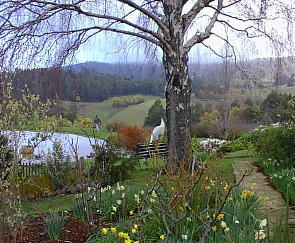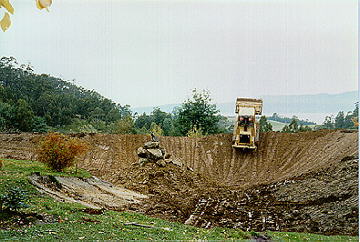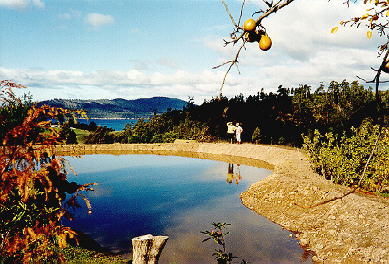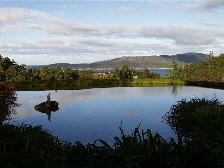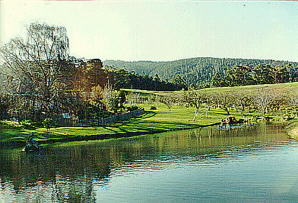TASMANIAN GARDENERS BUILDING PARADISE [CONTINUED]
THE BUILDING OF THE BIG POND
The time had come for serious discussions about the building of the water garden. The vista from the gardens around the house is very pretty, a gentle view that looks across the channel of the River Derwent to South Bruny Island. Between us and the Channel there is an area of an old orchard and cleared paddocks and I dearly wanted to have a sheet of water in front of the house. I believed that it would be effective in drawing the water view closer to the garden. It was bad luck that the slope of the land made this a very hard exercise.
At first Kees told me that the situation I chose for the pond was impossible. We compromised and pegs and ropes were put into position. Never having undertaken such an enterprise before, my imagination was singularly lacking. I was certainly able to see a wonderful blue sheet of water, stretching before my eyes, seemingly suspended in the air. But not once did I visualise the other ugly ponds that were dug to get the clay for the walls of the dam. Nor, in my wildest dreams, had I pictured the steep banks that were necessary to build a pond the size that I wanted and, indeed, that I insisted upon.
We arranged for the big machine to come and all week the excavator was busy. Clay for the walls was found nearby and the mess was unbelievable. We left and went back to Hobart for a few days. Returning on Friday, we found the project beginning to take shape. It was a big shock for me to see how enormous the crater was and the height of the walls was quite daunting. I became worried that this was to be my biggest mistake in our creation of the garden. Kees was very brief in his observations and remarked, "You must have known how tall the dam had to be, after all, I told you often enough, it is a very difficult site." I assured him I had no idea and that "I'm not an engineer and not being Dutch don't know the foggiest about building dykes and dams!" Kees treated this statement with the contempt it deserved.
All weekend we heard the drone of the machines and the noise became very grating on our nerves. We had become used to the quiet and peace of “Kibbenjelock” and resented anything interrupting that calm, excepting the calls of the birds. Every now and again, I would trot down to the chap driving the big yellow machine and we would chat about the length of time it was taking. He felt that he should have been provided with a bigger machine, this proved to be true but to get a machine on site costs a fortune so I secretly hoped that he would be able to finish the job with the machine he was using. It looked quite big enough to me and it certainly was quite efficient in digging the huge crater that got bigger and bigger as each noisy hour passed. The job was not finished by Saturday afternoon but the peace on Sunday was welcome to our ears.
Finally , the next Saturday early afternoon, Kees came and got me from the furthest corner of the garden where I was still trying to remove the twitch grass from the new Rhododendron walk. “We are ready to place the rocks for the “Black Cockatoo” and any where else you want them to go.” We had found some very large rocks in our bush and dragged them to the pond site, hoping that we could use them as a resting place for the beautiful bronze/ copper sculpture "The Black Cockatoo" sculptured by Stephen Walker.
This sounded the time for me to get my thoughts and ideas into a practical frame of mind. Excitedly, I ran to the site. The two men were tying a chain around a huge rock, the plan was for the machine to pick it up and arrange it on the little hill sitting in the middle of the gaping hole. The "hill" had been made by scooping up extra clay and stamping it down, just off centre of the big crater. This was repeated time and again. Then the machine was to settle the rocks firmly into the clay hill.
Over and over again, the machine shoved blades under the rock and over and over again the chain slipped off the rock. Finally, I rang Ray [ a local man who comes to help us when the task is beyond our capabilities]and called for his help. Good chap that he is, he agreed and suggested an extra chain he would bring may be of use. The men had a great time after that. Not that it always worked, but, a few times I saw Ray give the boulder a contemptuous kick and, as when you give your TV a bang to make it work, after the boot, the rock stayed chained. It then sailed through the air until it was lowered into the final resting place. Eventually three big boulders were in place.
Apart from the sculpture’s pedestal, I wanted a small outcrop of rocks at the two ends of the pond. The driver told me of a dam he had built where the stones had been placed in a circle, around the whole edge and how good it looked. I told him that we did not have enough time to fetch so many stones from the bush.
Late in the afternoon, Kees said to me “We can turn on the water now!” He had placed a bucket in the middle of the big hole and informed me that the large hose would gush the water into this to prevent it running hard onto the clay floor and making a mini crater. Ray and I went over to the home orchard garden to turn the big wheel that controlled the watering system and with a sense of drama, I turned the tap. This was going to help me realise my dream of a water garden. The small duty done, I rushed back to the pond but had to wait five minutes for the first spurt of water. We all stood there and watched, drinking champagne, as a little pond appeared which slowly got bigger and bigger. My impatience was cooled when the driver told me it would take at least three to four days to fill. The men drifted away but I sat on one of the boulders for a long time and dreamed my dreams.
In no time, I was joined first by the ducks, then by the cats and finally by the peacocks. They all marched around the perimeter of the pond, now and again sniffing and stopping to watch the water. The ducks chattered excitedly to each other and infrequently, the peacocks let out a shrill, mysterious and ancient cry.
It was with apprehension I returned to the property next weekend. Kees had come down mid week and turned off the water but it still needed more so it was turned on to run all night. The next morning I got up early and saw “my” pond in the early morning light. I looked over the stretch of water to the view of the channel and realised that it had really worked. The sheet of water reached out to the blue water of the channel, had made the view come closer and more intimate. It was a success. Sunday was Mothers’ Day and Francesca and Carol and Chris came for a visit. The day was a sunny Autumn’s day and the water was blue and reflected the magical colour from the Taxodium disitchum {Swamp Cypress} which had managed to turn the most marvellous , rich brown-orange, though still a very young tree. Two Dawn Redwoods {Metasequoia} were shedding their golden -brown leaves and stood to attention close by.
Francesca expresses how we all felt that Autumn afternoon, as she filmed the new addition to the garden on my video cameraq “Here is the pond and its got Stephen Walker’s sculpture and its got the ducks and its got the view of the Channel and its got - [long pause] - Well, everything really.” It was a very happy afternoon and the joyous feeling was helped by the drinking of champagne as we tried to name the pond. “Cockies Lake” someone yelled. “Cock up Lake” I shouted back. “Black Cockatoo Island” Carol suggested. “Big Fish Lake” this was in reference to an extraordinary thing that had happened the night before. A big trout of about three pound had managed to get into the pipes that carried the water between the two old dams on top of the hill. As we filled the new lake, the water in the dams was checked to see that we were not emptying our water supply and the fish had been found thrashing around on the bank of the bottom dam. Ray carried him down to the house and we let him go into the new pond. “Gay’s Folly” was considered seriously but finally Christopher poured some champagne into the water and announced, “I hereby name this stretch of water “The Big Pond”,” my suggestion from the beginning.
Despite our having to build the highest wall three times, there is no regret in the saga of my water garden. Each time the bank broke we suffered from bank accounts rapidly being depleted. The chaos of mud and yet another small pond being created to supply more clay we found difficult to live with. When the grass surrounds looked like a battle field before the gardens were opened under the Australian Open Garden Scheme the first time, that also was hard to bear. In my opinion, the Big Pond [Cinderella] and her three ugly sisters add a dimension to the gardens that is worth all the money and despair. Early morning or on a beautiful, clear day, the effect of the water reflecting the sky and the few trees growing nearby, is something quite special. When the mists descend down the hills, the Big Pond takes on a romantic, dramatic mood like a scene from “Wuthering Heights.”
I have kept the planting quite simple. Gunneras, the giant rhubarb like plant, breaks the perimeter on the left side. There are three Japanese cherries planted nearby and a Cedar Atlantica will reflect in the water some time in the future. The steep bank is being planted with cuttings from the Sandy Bay garden of an Australian rose, one of Alistair Clarke’s, “Bloomfield’s Courage.” This rose is a scrambler which covers itself with small crimson flowers for a long time in early summer and in no time should cover the ugly wall with a blaze of scarlet for many weeks. Then we can forget the trouble the bank caused us and shake our heads and say wisely, “Its out of ill winds that no good grows.” On the bank closest to the house, there is a planting of Louisiana Iris, Japanese Iris [Kaempferi] and Iris pseudacorus, the yellow flag. These, rapidly moving into the water, are interspersed with various Candelabra Primulas that Kees grew from seeds obtained at Cluny House Garden in Scotland.
Most of the plantings around the Big Pond and the three little ponds are from plants growing in the Orchard Gardens. We have so many seedlings growing up, bushes that layer themselves and plants that need deviding , I am always calling out to Kees , “Here’s another thing for the Ugly Sisters to wear to the ball!” At the end of 1993 we saw the first wild wood duck or maned geese visit the water gardens. Already the native hens had reared many children and a pair of swallows return each year in September to swoop and dart around the “Big Pond”. I long to see a pair of swans take up residence but so far I wait and hope. Kees put some trout fingerlings in with his desire to be able to walk to the front of the house and catch a trout for breakfast. Twenty four hours later, the first cormorants and herons were seen at odd times, waiting silently on the banks of the pond and by the end of summer it appeared they had managed to catch every little fish. We had never seen these particular birds at “Kibbenjelok” and it amazed me that they discovered their easy pickings so quickly. We now have frogs that can be heard all night courting one another. The night noises do worry our weekend visitors though Kees and I are used to them and have no sleepless nights

A fun photo of me, dressed for my daughter Francesca's Wedding. Not for the Garden!!!
Visit my monthly journal site at Suite 101. Every month I will be showing beautiful photographs of what is in flower in the garden at that time. I am an editor for Suite 101 and I am filed under, "Contents" Gardening,"Tasmanian"
